THE NATIONAL GEOGRAPHIC MAGAZINE (1915) - ARMENIA AND THE ARMENIANS
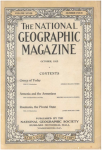 ARMENIA is a word that has widely different connotation for different peoples. To us Americans it means a vague territory somewhere in Asia Minor; to the makers of modern maps it means nothing - there is no such place; to the Turks of a few years ago it was a forbidden name, smacking of treason and likely to bring up that buga boo "nationalism." than which Abdul Hamid II feared nothing more, unless it were "liberty", but to nearly two millions of Russian. Persian, and Turkish subjects it is a word filled with emotion,one that sends the hand to the heart and calls up both pride and sorrow.
ARMENIA is a word that has widely different connotation for different peoples. To us Americans it means a vague territory somewhere in Asia Minor; to the makers of modern maps it means nothing - there is no such place; to the Turks of a few years ago it was a forbidden name, smacking of treason and likely to bring up that buga boo "nationalism." than which Abdul Hamid II feared nothing more, unless it were "liberty", but to nearly two millions of Russian. Persian, and Turkish subjects it is a word filled with emotion,one that sends the hand to the heart and calls up both pride and sorrow.
Armenia is not easy to bound at any period of history, but, roughly, it is the tableland extending from the Caspian Sea nearly to the Mediterranean Sea. Its limits have become utterly fluid; the waves of conquering Persians and Byzantines.
Arabs and Romans, Russians and Turks have flowed and ebbed on its shores until all lines are obliterated. Armenia now is not a State, not even a geographic unity, but merely a term for the region where the Armenians live (sec map. page 359).
LARGER THAN GERMANY AND FRANCE
At the height of its power and at its greatest extent the ancient Kingdom of Armenia consisted of 500,000 square miles of fertile tableland, extending from the Black Sea and the Caucasus Mountains to Persia and Syria. It rises until it reaches 8,000 feet above the sea, then it ascends abruptly to the snow-capped peak of Mount Ararat, which is 1,000 feet higher than Mount Blanc. The land is fertile, nigged, and beautiful. A native of the country writes of it with pardonable enthusiasm thus:
"Armenia is the motherland the cradle of humanity, and all other lands are her daughters; but she is fairer than any other. Even her mountain tops of perpetual snow are a crown of glorv: the sun kisses her brow with the smile of morning, and she supplies the beautiful rivers Euphrates, Tigris, Pison. Araxes, and many others from the jewels of her crown. These rivers penetrate to every corner of the land, traverse many hundreds of miles to give life to the fields, the vineyards, ami the orchards, to turn the mills, and finally close their course in the Caspian Sea, the Black Sea, and the Gulf of Persia, carrying the bounty and good-will messages of the motherland to her children in remote parts - to Persia, India, and Russia. From the same inexhaustible reservoirs she feeds her noblest lakes — Sevan, Unimiah, Van, and the rest.”
TWO MELONS A CAMEL'S LOAD
This country of Asia Minor is a fine grazing land and an excellent agricultural region. It is so fertile that two melons are said to be a camel's load, and it produces grapes. wheat, Indian corn, barley, oats, cotton, rice, tobacco, and sugar: all the vegetables that we know in America, quinces, apricots, nectarines, peaches, apples, pears, and plums. The Armenians export silk and cotton, hides and leather, wine, dried fruits, raisins, tobacco, drugs, and dyestuffs.
In minerals, too, the country is rich. Coal, silver, copper, iron, and other minerals lie beneath the surface, but the Turkish government has not allowed them to be exploited.
James Bryce thus speaks of the land:
“Here is a country blest with every gift of Nature; a fertile soil, possessing every variety of exposure and situation; a mild and equable climate; mines of iron, copper, silver, and coal in the mountains; a land of exquisite beauty, which was once studded with flourishing cities and filled by an industrious population.
"But now from the Euphrates to the Bosphorus all is silence, poverty, despair. There is hardly a sail on the sea, hardly a village on the shores, hardly a road by which commerce can pass into the interior. You ask the cause and receive from every one the same answer - misgovernment, or rather no government; the existence of a power which does nothing for its subjects, but stands in the way when there is a chance of their doing something for themselves. The mines, for instance, cannot be worked without a concession from Constantinople."
NO BRIEF CIVILIZATION
Into the soil of this beautiful and historic land the Armenians have thrust deep roots. No brief civilization is theirs dating back to Mayflower or even Norman Conquest, but one that is almost coterminous with recorded history; and every Armenian feels behind him this vast antiquity, giving him personal dignity and great national pride. They begin their history with the Garden of Eden, which they claim was in Armenia, basing the claim 011 the naive statement that the land is beautiful enough to have included Paradise, and also laughingly asserting that the apples of Armenia were worthy to tempt a most Epicurean Eve. Their first recorded ancestors they find in the book of Genesis.

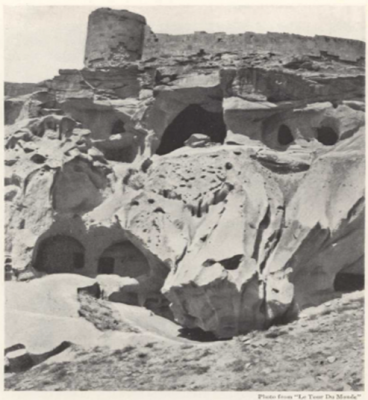
THE RUINS OF ANI, THE ANCIENT CAPITAL OF ARMENIA
During the early Middle Ages the Armenians, who have long been under Turkish rule, were independent. Ani was their capital, and it had its fortresses, palaces, and churches. Many of them are still standing, hut the city does not contain a single inhabitant. It fell into the hands of the Turks in the fourteenth century and was desolated. For 500 years patriotic Armenians have returned from time to time to this sccne of their former greatness, usually dwelling in its grottoes during their stay. These grottoes were hewn out o f the solid rock upon which Ani was built.
Russian Armenia consists of the provinces of the Caucasus, and further south the sun-baked plains leading to the base of Mount Ararat, where, in the midst of fields, vineyards, and cultivated fields, lies Etchmiadzin.

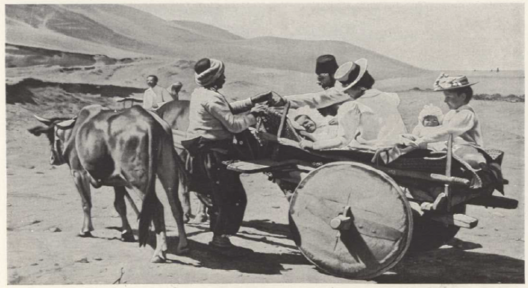
THE MOST COMMON' VEHICLE IN ARMENIA
"Armenia is not easy to bound at any period of history, but. roughly, it is the tableland extending from the Caspian Sea nearly to the Mediterranean Sen. Its limits have become utterly fluid; the waves of conquering Persians and Byzantines, Arabs and Romans, Russians and Turks have flowed and ebbed on its shores until all lines are obliterated. Armenia now is not a State, not even a geographic unity, but merely a term for the region where the Armenians live” (see text, page 329; also map, page 359).
A taste for the arid red plains of Asia Minor, with their occasional beautiful tree or still rarer blue lake, is, I think, an acquired one, although I confess to sharing the love of the native for this brilliant land, where the soil is so red and the sky so blue and each tree is like a distinct personality. I know how homesick for this land the Armenian can be when he comes to our shores; I know how the iridescent lights fall on rolling lands, and how the gay flowers dot the fields in springtime, and how so many towns nestle in the “ shadow of a great rock."

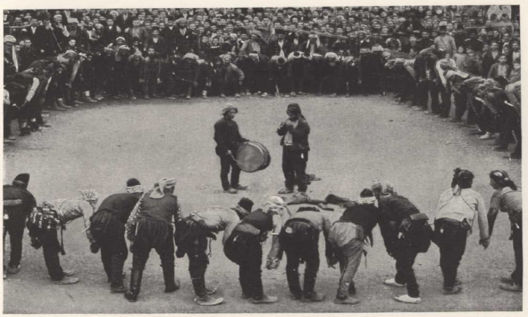
ARMENIANS DANCING
The Armenian national dance is not such a thrilling affair as the fox trot, neither does it have the stately grace of a Virginia reel. It reminds one more of a rhythmic "Ring around the Rosey," like the Bosnian national dance.
But no one could fail to admire the beauty of the Caucasus at first sight. It is hard to conceive a more wonderful journey than that over the Georgian road from the Georgian-Armenian city of Tiflis up into the fastnesses of the mountains, culminating in a face-to-face view of superb glacier-clad Mt. Kasbek, then down through the historic Gorge of Па riel to the plains once more.
THE ARMENIAN CHURCH
The Armenian Church is called after Gregory the "Gregorian," assuming no such pretentious title as "Orthodox" or "Catholic." It differs from the Greek Church very little in creed, but, unlike the Greeks, the Armenians are not theologically inclined, and lay little stress on doctrine. They have always been, however, devotedly trinitarian.
The Armenian Church has been persecuted not only by Moslem and Fire-worshiper, but also by Roman and Greek; yet it is one of the beautiful characteristics of this ancient church that it never persecutes in its turn. It fellowships with all churches, holding that Christianity means brotherhood through Jesus Christ and gives no warrant for oppression or anathema.
The music and ceremonies are naturally very primitive, dating back to the time when the courtyards of the church were the dramatic centers of the parishes and moral and spiritual lessons were taught through simple drama. Such services as those of llolv Week, observed even in our own time, illustrate this; for instance, the washing of the disciples' feet and the literal raising of Jesus by pulleys up a tower. The Greek Church preserves similar primitive histrionic services. Armenians love their church devotedly, and say that although they may get more instruction from a Protestant sermon, their own services seem to them warmer, touching their emotions and helping them.
ARMENIA'S ROME
The center of the Armenian Church is at Etchmiadzin, in the Caucasus Mountains, where stands the fine old cathedral built eight hundred years ago in response to a vision. This church, square and surmounted by an octagonal tower, with courtyard and outbuildings, and its altar in the center, has been a model for Armenian churches ever since: while the little chapel to Saint Gregory, in form a canopy, has become the type of the peculiar porches that are usually attached to Armenian churches. The cathedral contains a miraculous picture of the Virgin, many sacred relics, and the sacerdotal oil. with which every true Armenian must be anointed at his birth, his marriage, and just before his death. This oil is distributed for use to every Armenian church. There are also at Etchmiadzin gorgeous vestments, tanks of celebrated fish, a world-famed library containing 3.000 illuminated manuscripts, and some old portraits. Schools and an ecclesiastical college educate the Armenian youth for the priesthood.
Here under the shadow of Mount Ararat lives the “Catholicos,” or pope of the Armenian Church, a stately man in splendid robes and hood, accompanied
when he goes out by a bodyguard in scarlet and gold. The present Catholicos is George V. Surenian, the 127th Catholicos in regular succession from Gregory the Illuminator. Such is the oldest Christian Church.
Before we turn to the history of the Armenians let us consider their race and characteristics.
RESEMBLANCE TO THE JEW
Their appearance is definitely eastern; swarthy, heavy-haired, black-eyed, with aquiline features; they look more Oriental than Turk, Slav, or ('«reek. In general type they come closer to the Jews than to any other people, sharing with them the strongly marked features, prominent nose, and near-set eyes, as well as some gestures we think of as characteristically Jewish. The type is so pronounced that to those who are akin to them they seem often very handsome, while to westerners they seem a little too forcing-looking. O f course, the type is not always preserved: white skins, even an occasional rosy cheek may be seen, and there is a small number of fair-haired and blue-eyed Armenians.

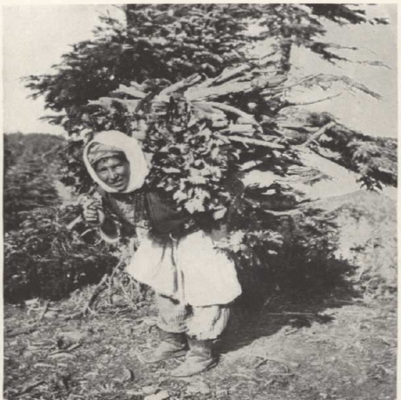
AN ARMENIAN WOMAN, A MOUNTAIN DWELLER, CARRYING A GREAT LOAD OF FIREWOOD DOWN THE ROUGH MOUNT INSIDE
The Armenians are the workers of the Near East. Added to a business ability superior to that of the peoples around them, they have, in sharp contrast to their Asiatic neighbors, great capacity for work and well-dircctcd frugality.
The resemblance to the Jews does not stop with physical features, for the fate of the two peoples has been sufficiently similar to bring out common traits, like the Jew. the Armenian has been oppressed and persecuted, and has developed a strength of nationality, a love for his own people, and a persistence of type rarely seen elsewhere. Like the Jew, he has learned to bend, not break, before the oppressor, and to succeed by artifice when opposed by force. How else had he survived? Like the Jew, he has developed strong business instincts, and like him he has a talent for languages, a power of concentration, and unusual artistic gifts. Roth Jews ami Armenians are very clever actors.
These resemblances have made many scholars question whether the two races are not akin: whether the Armenians may not be descended from the lost Ten Tribes of Israel. Rut the philological basis for such an hypothesis is lacking, and the Armenians and their language are adjudged to be not Semitic, but Aryan.

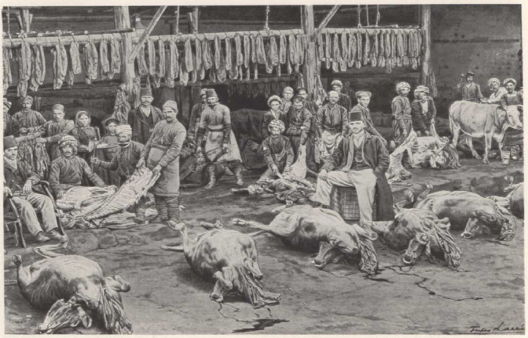
ARMENIANS PREPARING "BASTOURMK," BEEF DRIED IN THE SUN, NEAR VAN
Mу Armenian friends are to be found largely among my Armenian students at Constantinople, some fellow - teachers, and a few faithful servants.
When the present college was founded, a mere primary school called the Home School, its first students were Armenians eager to get an education. For many years the Armenians were the most numerous of the nationalities present. Scutari. where the college was situated until it moved across the Rosphorus last year, is au Armenian quarter, so that long after Greeks and Bulgarians came in larger numbers into the boarding college the day scholars were predominantly Armenian.
ARMENIANS AS STUDENTS
As students the Armenians differ among themselves, ranging all the way from flense stupidity to brilliance, but averaging high in their studies. Of the three students who distinguished themselves in philosophy in a dozen years, one was Turkish, one was («reek, and one Armenian. In English composition, while perhaps the cleverest ami most humorous papers were written by Greeks, anti the stories with the most action and vim by the liulgarians, those showing the most grace and fancy were written by Armenians. Oriental girls rarely enjoy mathematics, but the one student who so craved mathematics that the professor in that department had to form special classes to give her all that advanced American colleges offer was au Armenian.
The college chorus and choir always contained many Armenians, and in my day the special soloist on all occasions was an Armenian who sang like a bird, with natural style. She has since studied music in Paris, and is now doing concert work in Constantinople. Like other Orientals, the Armenians have dramatic ability. I well remember one strongly featured Armenian girl who acted the double role of priest ami king in a Sanskrit play with marked effect. I recall in that same year a pretty Armenian girl who played the part o f Toinctte in "Le Malade Imaginaire" with more charm anti piquancy than I have seen in any American production o f that classic. The pronounced features and splendid eyes ami hair of so many Armenians make them extremely effective in tableaux.
FULL OF SENTIMENT
Armenian women are full of sentiment and emotion, and unless they have been repressed by harsh experience they are unrestrained in expression. When the news of the death of a schoolmate reached one o f our dormitories, the girls wept anti even screamed with such abandon that one of them became actually ill and had to go home. Yet under torture and persecution these women have shown marvelous paticucc and endurance.
Where there is so vigorous a national pride, some personal conceit would naturally follow. That is not always the case; some of the most modest and humble of women are among my Armenian friends: but a characteristic expression of complacency that tine often hears is: "He is a fine man: he likes me."
In these young girls does one find any reflection of tragedy of the race? Yes, one does, although many an Armenian girl of prosperous family is as gay and light-hearted as a French girl. Let me tell of a few of our girls, giving borrowed names.
Filore was a sparkling girl, with jet black hair and shining eyes and teeth. She was delightfully responsive in class, although her quick appreciation was rather shallow. She was always happy and care-free. Her father was high in Turkish favor anil she had apparently no consciousness of her people’s sufferings.
Zabelle was another happy girl, but of quite a different type. She was small and plump, and maintained a position at the head o f her class only by constant hard work. One would never associate her with tragedy in the remotest way. But when, in hjoK, people’s tongues were loosed, the press freed, ami people seemed to wish to express their long pent-up emotions. Zabelle wrote a composition. She began in her clear round hand, "I liave always wanted to tell about my cousin Mesroh, but I did not dare; now I can speak," and there followed a horrible tale of persecution, torture, and death inflicted on an innocent young man.

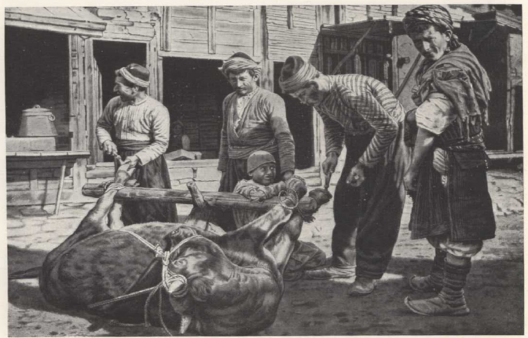
SHOEING AN OXEN THE VILLAGE MAIN STREET: VAN
"MY COUNTRY"
Heigoohee was touching in her expression of the joy that it gave her after the revolution of 1908 to be able to say "My country," for she had always felt so lonely when among girls who had countries of their own, such as the English and Turkish girls.
One of the sweetest souls I ever knew was Annitza. She was a Protestant from one of the mission schools in Cilicia. She was older than most of the girls, a woman in character and suffering. She was very delicate and unconsciously appealing. and absurdly grateful for any little thing that was done for her. Her appreciation of beauty was very great.

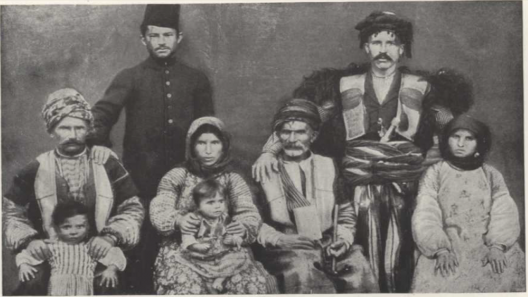
AN ARMENIAN FAMILY OF VAN
"Their appearance is definitely eastern; swarthy, heavy-haired, black-eyed, with aquiline features, they look more Oriental than Turk. Slav, or Greek. In general type they come closer to the Jews than to any other people, sharing with them the strongly marked features, prominent nose, and near-set eyes, as well as some gestures we think of as characteristically Jewish” (see text, page 334).
Once I took her to see the wondrous mosque Sancta Sophia, in Constantinople, with a class o f girls. She wandered off by herself, and when I found her she was sitting quietly wiping the tears from her eyes, because it was "so beautiful." Annitza was one of three girls who came from the district of Adana, where the massacres took place in the spring of 1909. For several weeks we gave these girls a separate place to eat and sit while waiting for news of their loved ones. One day I met Annitza in the corridor and uttered a light word. Her face stopped me, and I said quickly. "Bad news. Annitza?" She made a pitiful effort at self-control, then said "Oh, teacher, eleven of them!" and despite the respect that keeps an Oriental girl from familiarities with a teacher, threw her arms around my neck and wept. And that was not the whole tale. The next week added four more to the list of victims in her family. Patient Annitza, with her soft pathetic eyes, always seemed to me a type of the Armenian victim.

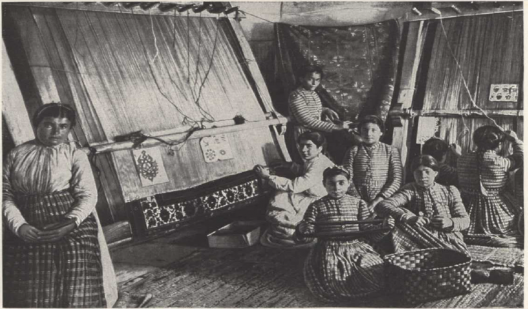
ARMENIAN GIRLS WEAVING RUGS AT VAN
There is a large American mission at Van. with schools, an orphanage, and a resident doctor. A French Dominican Mission, also, before the present war, maintained a school here.
A DISILLUSIONED SOUL
Hrypsime was not a type at all: she was a strangely individualized girl, but the product of suffering and revolution. One would not have thought it to see her in school, eager to learn, docile, appreciative of all little gaitics, patient in her poverty and humiliation. She was sea red V over 15 years old, a preparatory student, but her compositions revealed an embittered, disillusioned heart. She also began to express herself after 1908 and poured out tales of persecution and revolution with bitter vindictiveness and hate. On the day of the battle. April, 1909, Hrypsime ran off to join the Red Cross. When I asked whether her mother knew, she shrugged and said: "My father gave his life for revolution: why should I try to save mine?" I do not know what has become of her, but I have often hoped that some one has been able to put into her heart the love and faith in man and God that her cruel childhood seemed to have crushed out.
No account of my Armenian friends would be complete without mention of Hozanna, faithful servant for 30 years at Constantinople College. Dear Hozauna, of the beatific name, the Madonna eves, and the ample bosom, who gave "my teachers," as she called us, the home feeling, who sent us forth for our vacations with the phrase "Go with smiling," and welcomed us back with soft words of greeting.
To you, Hozanna, living your life of devoted service to the Americans, to you, and through you to the Armenian nation. I send my salaams.

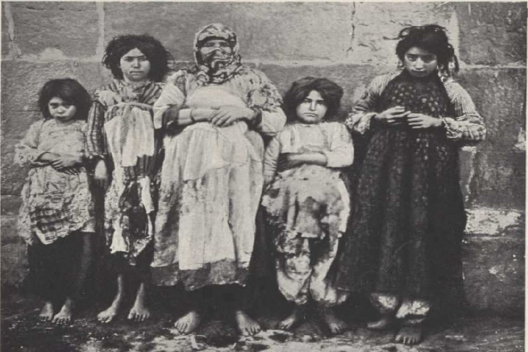
ARMENIANS
TYPICAL TOWNS
A typical Armenian town of the better class is Rardezag, near the Gulf of Nicomedea. This is a town of narrow streets, paved with great stones and bordered by dark, narrow houses made of the unslaked brick of the Scjptures, but with the straw much in evidence. The edges of the streets serve as gutters, and the doorsteps over them are littered with children. There is one school-house which is a sort of social center, serving as lecture-room or concert hall at need. There is, of course, the square Gregorian Church. There is also a silk mill, and the fields are filled with mulberry trees wherewith to feed the hungry silkworms. On the edge of the town are an English orphanage, founded after the massacre of 1896. and an American college for boys, the latter being the great center for enlightenment for the neighborhood. The fields are fertile and well tilled, but beyond them rise beautiful hills, whence descend the marauding Kurds to reap where they have not sown. The people are largely agricultural, although there are many of them engaged in the intellectual and business interests of the town. The women wear Oriental costumes - bloomers, dark bodies folded across their breasts, hair braided in two or more braids, often dyed with henna, and when on the street a kerchief over the head. Most Christian women in the
interior of Turkey find it safer to veil when abroad. In Constantinople the Armenian women dress like Europeans, but rather more showily. The men of Bardezag dress like the Turks, in loose collarless coats and the red fez, but in Constantinople dress like Europeans. There is considerable intellectual activity in llardezag, and some noted revolutionaries have gone forth from that town.

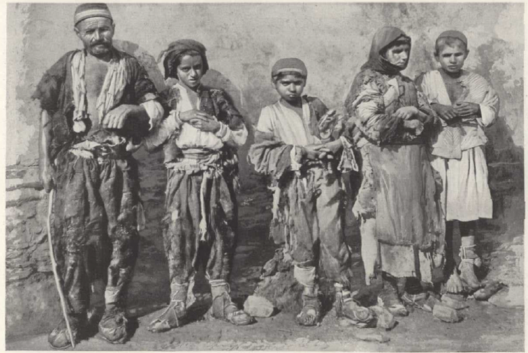
AN ARMENIAN VILLAGE
An Armenian village of the primitive sort is Chalgara. When an American missionary brought rejxirt of this wretched little village, separated from its neighbors by the impassable roads, where the people were lost in ignorance ami dirt, an Armenian lady, graduate of Constantinople College, offered to go and live with them. She took up this hard and disgusting life: she is teaching the people to read and write, to be industrious and honest, to grow vegetables and make clothes, to scrub their houses and say their prayers. Such is the work a consecrated Armenian can do for her people.
The best-known Armenian towns are Erzcroum, a fortified town containing interesting remains of the Seljuk Turk rule; Kharput, a little town 4,350 feet above the sea: Uitlis, not far from Van; Van itself, 011 the befiiitiful blue lake of the same name; Diarbekir; Marash, near stately Mount Tarsus; Tarsus and Adana, in the same district of Cilicia, and Marsovan. In all of these towns the population is partly Christian, partly Moslem, with enough armed Kurds to terrify the Armenians. Over the frontier, within Russian Armenia, lie Erivan and Etchmiadzin, with the city of Tiflis, which is largely Armenian. One of the great Armenian cities, now but a heap of ruins, was Ani. in Cilicia, which was excavated in the last century and shows traces of a high civilization. Here are to he seen remains of conical-roofed churches and massive walls 40 to 50 feet high, flanked by many round towers and protected on two sides by deep gorges. Yellow stone-work, black basalt, decorative sculptures in the churches, rude carvings in the caverns, and faint remains of colored frescoes indicate an art development of no mean order.
BRYCE'S TRIBUTE
Janies Hryce, in his “Transcaucasia and Ararat," writes of Ani (see p. 331): "These monuments leave 110 doubt that the Armenian people may be included in the small number of races who show themselves susceptible of the highest culture. They exhibit the Armenians as able and sympathetic intermediaries between the civilization of the Byzantine Empire, with its legacies from that of Rome, and the nations of the East. They testify to the tragic suddenness with which the development of the race was arrested at a time when their capacities thus formed were commencing to bear fruit."

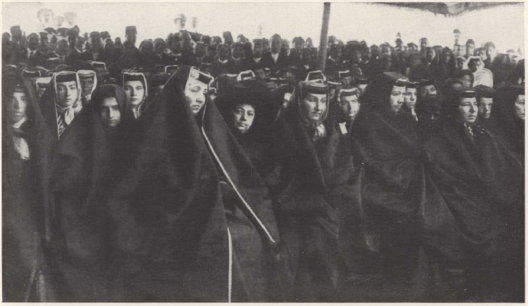
ARMENIAN WOMEN LISTENING TO A SERMON AT TIIE FUNERAL OF AN ARMENIAN ARl'HUISHOP AT TEHERAN, PERSIA
Turkey is not the only country in the world with an Armenian population. Out of 2,900,000 Armenians now living, approximately 1,500,000 live in Turkey, 1,000,000 in Russia, 150,000 in Persia, and 250.000 in Europe, the America, and the East Indies
The city of Ani did not last long. It fell into the hands of the Hyzantines and was destroyed not long after. Its fate is sadly symbolic of the fate of Armenian homes from that time to our own.
AROUND ARARAT
Emerging from tradition, a distinct Armenian people appears about 1000 B. C., dwelling on the table-lands near Ararat. Having no natural boundaries, the State was seldom independent, but was subjugated in turn by Babylonia, the Medes and Persians, the Seleucide and the Romans. The ancient Oriental idea of conquest left, however, a good chance of national development. Conquest meant little more than tribute. The Armenians boast of a proud culture during the ancient period ami lines o f noble kings. The Armenians were closely allied to the I’arthians bv religion, culture, and propinquity, anti were one of the few ancient peoples who were never Hellenized.
It is in the early Middle Ages - ages that we of the West call "dark," but that to the Xear Hast was a period of great culture— that Armenia attains its highest position, and it is through Christianity that it made its contribution to the world.
In the year 310 A. D., 15 years before the establishment of the Greek Church, the Armenian Church was founded by Krikor or Gregory the Illuminator, and Armenia became the bulwark of Christianity in the East. Gregory was baptized by Christian relatives in his childhood. His story is an interesting one. telling of an early marriage, the birth of two sons: then of his "vocation" and entrance into a monastery; of his attaching himself to Tiradates, who soon became king; of Tiradates’ persecution of Gregory because he would not accept the old gods: of years in prison; of his release in response to a vision; his miracles: the conversion of Tiradates and the baptism of a thousand Armenians, until in eight years Armenia was fully Christianized and the religion was adopted by the State.

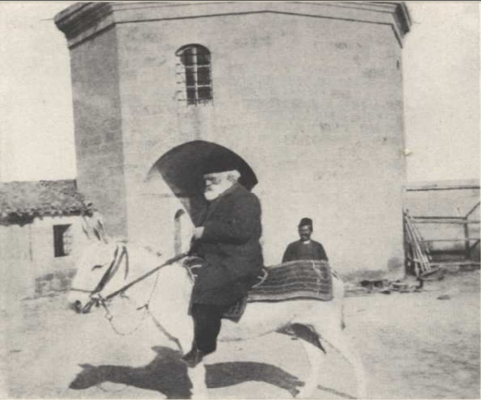
THE LATE PROFESSOR H. BEZJIAN
A distinguished Armenian citizen of Aintab and Professor of Physics in Central Turkey College
The mummied liand of Saint Gregory is still laid on the head of every bishop at his consecration, thus carrying on the most perfect apostolic succession in the world.
TRANSIENT GLORIES
The glories of independent Armenia quickly passed. With the seventh century there arose a power in the East more fatal to Armenia than any of her ancient enemies— the religion of Islam. Like wildfire, the religion of Mohammed spread from Mecca to Gibraltar; lmt when it reached the Armenian people it found a substance it could not consume: the Armenians could not be converted to Islam, although their kingdom could be burned to ashes and their people enslaved. Like fire and water, Islam and Christianity met and struggled, but neither could destroy the other, until they settled down in the same land, sullenly irreconcilable. The races might long ago have been blended, for they arc not temperamentally antagonistic, but, on the contrary, well fitted to lie friends; but the two clashing religions, each claiming the world for its kingdom, could never be reconciled.

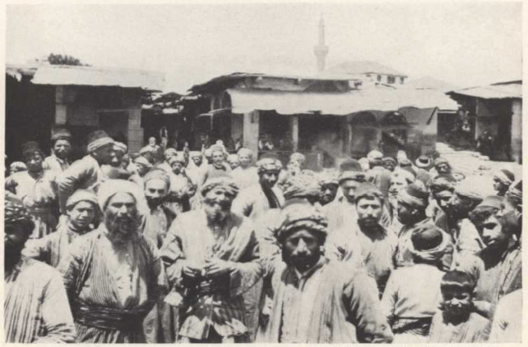
A CROWD OF TURKS IN THE MARKET-PLACE OF AINTAN
"In the courts of justice the word of an Armenian will not be taken against that of a Moslem. . . . No Armenian's life, his property, nor the honor of his women has been safe in Turkey for a century" (see text, page 354).
First, as the followers of the Prophet conquered Syria and the Armenian provinces of liyzantium, came the Arabs; later came the Seljtik Turks and subjugated part of Armenia, and finally the Ottoman Turk conquered a vast empire and set up his mosque in Agia Sofia.
Mohammed the Conqueror had not enough Moslem subjects to fill his empire or his conquered city, so he accepted his great hotly of Christian subjects with tolerance of their laws, customs, and religion. Many Turks today think that if he had pursued a policy similar to that of modem Russia and Germany, ruthlessly Turkifving and converting to Islam his foreign subjects, he would have made a homogeneous and happy Turkey. But he left the Rayahs, or Christians, contemptuously alone, granting them, however, no civil or military advancement unless they accepted Islam.

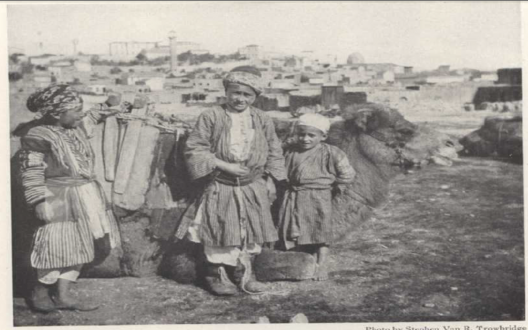
KURDISH CHILDREN OF THE CITY OF AINTAB
The Ottoman Empire was organized into millets, a religious division, there being an Orthodox millet, a Gregorian millet, a Catholic millet, ami a Jewish millet, ami in the nineteenth century a Protestant millet. Each of these millets has its head, who is its representative or ambassador at the Porte. This is not a purely ecclesiastical position, like that of the Catholicos, but is really a diplomatic and political office, and demands intellectual rather than spiritual qualifications.
PATRIARCH NOT ALWAYS RELIGIOUS
Therefore the patriarch of the Armenians is not necessarily nor by any means always a religious man. although an occasional patriarch, like Ismirian, is worthy of great rcverence. It is in this entanglement with politics, and in its ancient ritual in a dead language that lie the dangers to the Gregorian Church, namely, formality and lack of application to daily living. One of the best things that Protestant missionaries have accomplished in Turkey is revivifying this ancient and noble institution. It will reudily be seen that when an Armenian leaves the Gregorian to join a Catholic or Protestant Church he in some sense loses touch with his nation, for nation or millet and church are practically one in Turkey. For this reason, if for 110 other, all missionary work within the church is better than that done outside.
Turkey governed very well, as governments went, in the first centuries of her rule, and the Armenians were not unhappy. They were not admitted to the army, but paid a head tax instead; but many of their men, cleverer than the Turk in finance, became advisers to royalty. The Armenians formed the body of industrious farmers in Asia Minor and were useful business men in the coast cities, where they won respect and envy. They have alwavs been loyal citizens of Turkey, but they have not become converts to Islam, nor have they voluntarily intermarried with the Turks.

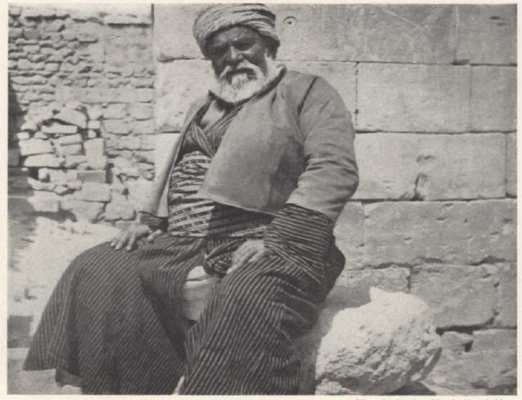
HAJI AGHA, KINDLY NEIGHBOR AND MOST LOYAL FRIEND TO THE AMERICAN HOSPITAL IN AINTAB
In the massacre of 1895 he posted himself at the hospital entrance and prevented the mob from entering. Me represents the better type of Moslem, who are not responsible for the Armenian massacres.
One curious instance o f their separateness from their political masters is in their use o f the Turkish tongue. Although the Armenians have lived centuries among the Turks, and many have been brought up in the Turkish rather than the Armenian language, they seldom speak Turkish without a very strong accent, amounting to a mispronunciation. It is one of the ways in which they have preserved their national individuality. There is little, if any, racial antagonism between Armenians and Turks. 1 lad religion and politics never come to antagonize them, they could live together in essential harmony.
ARMENIA'S GOLDEN AGE
The Armenians boast a Golden Age in literature, when for a brief cycle of fifty years their writers burst into poetry and song, leaving a precious heritage of literature to their descendants. This period was ushered in by Saint Mesrob, himself a scholar in Greek, Syrian, and Persian, who took the limited Armenian alphabet and perfected it to express the Armenian language. It had thirty-six letters, but two have since been added.
Mesrob, aided by Sahag, next translated the Bible into Armenian and furnished the translation that is still used in the Gregorian Church.

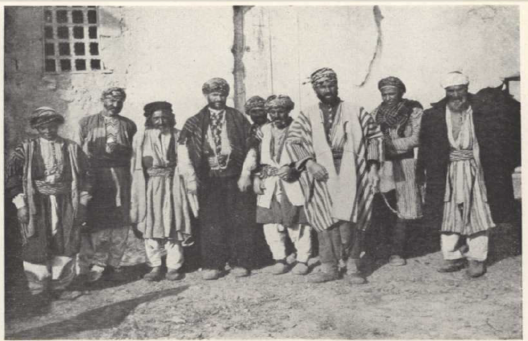
TURKISH VILLAGE CHIEF (FOUR TH FROM THE LEFT) AND HIST RETAINERS
Probably no people in history, not even barring the Jews, have been the victims of such a relentless persecution as the Armenians in the past third of a century. Sometimes the storm has abated its fury, only to start up again with increased energy, and the present terrible era in Armenia is but the climax of a generation of terror. In 1893 some of the Armenians sought to throw off the Turkish yoke. The revolt was quelled, and thereafter followed a brutal massacre in which thousands of lives were lost. In June, 1896, a disturbance in Constantinople, carefully planned and engineered by Moslems, broke out and before it wore itself out between 6.000 and 7.000 Gregorian Armenians had been slaughtered in Constantinople, and from 20,000 to 25,000 outside of the Turkish capital. The actual perpetrators of the massacre were the local Moslems, aided by Kurds, Circassians, and Lazis. The best Moslems opposed it. but the ignorant and fanatical masses were stirred by a report that the Powers were going to cooperate with the Armenians in driving them out. Furthermore, their cupidity was appealed to by the fact that they would thus lie able to wipe out the heavy debts they owed to Armenian peddlers and merchants. Horrible as have been the Armenian massacres of previous years, they arc surpassed by the terrible conditions of 1915. The world has never seen a more furious effort to drive out a people, or more cruel methods in their execution, than arc now being employed against this unhappy race.
Sahag also wrote epistles to many knights and emperors, all of whom, we are told, reverenced him and were greatly influenced by the saint. I Ie wrote a large part of the Armenian Church history and composed many hymns. Another great name of this period is Moses of Khorene, who wrote a history of Armenia which presents tradition, old stories and ballads, and some real history. Although it is full o f mistakes, it was the only source o f Armenian history for a thousand years and has much real value. Another valuable contribution to the learning o f the Middle Ages was the translation from the Greek of many classics, some of which, notably a part of the writings of Eusebius, were lost in the originals and preserved to the world only through the Armenian translation. The Armenians are very proud of this classic literature and teach it in all their schools. There is today a revival of Armenian literature, modeled in part on these revered classics and in part on French and English modern writings. The Armenians have a sense of style, a flow of language that often makes for oratory and fine writing. The Armenian language is rich, hut harsh and guttural. Scholars say that it is an Indo-Iranian tongue, unique in its development. But the most beloved of Armenian heroes, dearer than the mighty Dickran or Tiradates, greater than Saints Sahag and Mesrob, was Vartan. The story of his brilliant youth and the favor of Constantinople and Persian court; of his strong manhood, tested by the fierce persecution of Christians by Persia; of his military genius and success, and of his heroic death in the final battle that won Persian tolerance for Christianity, is one that Armenians never tire of relating. What solemn enthusiasm the students of Constantinople College always brought to the observance of "Vartan's Day!" With what praises of their national hen» did they fill their compositions, and what pride o f race shone in their sparkling eyes!
THE ARMENIAN QUESTION
The "Armenian Question" was brought about by the entrance of Russia upon the stage. Toward the end of the eighteenth century the province of Karabag, peopled by 200.000 Armenians and 100.000 Moslems, and governed by Armenian chiefs under the suzerainty of Persia, was conquered by Russia, so that Armenia is now divided between Persia. Russia, and Turkey. The Armenians in Persia have been treated well and arc content; the Armenians in Turkey were enjoying fair treatment up to 1876.
But the trouble had begun, for Russia had framed a policy for the protection of the Rayahs of the Otoman Empire and annoyed Turkey greatly by her intervention and demands for "reform." At first it was her coreligionists, the Orthodox Christians. Slav or Greek, whom Russia sought to protect, but later it included the Armenians.

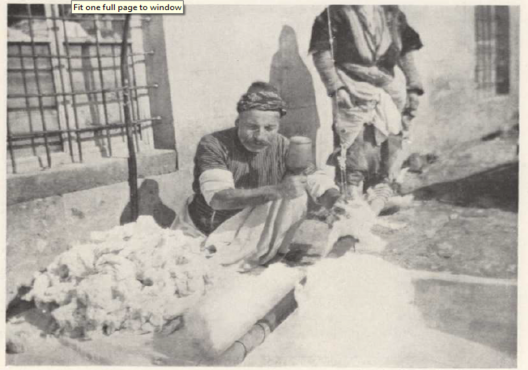
BEATING UP OLD COTTON: AINTAB
Mattresses and pillows are made over every year. The old cotton (tacking is fluffed, cleaned, and aired by means of a great bow and a tightly drawn gut which is struck with a mallet.
In 1876 there caine to the throne of Turkey one o f the most cruel ami abominable tyrants whom the world has ever known - Abdul Hamid II. Shortly after occurred the Rttsso-Turkish War. At the Treaty of San Stefano, that closed the war, the grievances of the Armenians were definitely put forward, and Russia engaged to carry out reforms "in the provinces inhabited by the Armenians and to guarantee them security against Kurds ami Circassians."

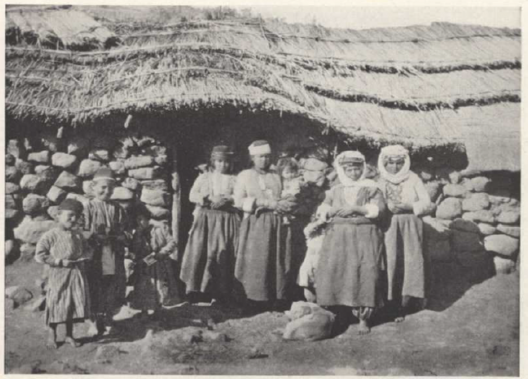
AN ARMENIAN FARMER'S FAMILY
"The purpose of the massacres seems to have been to reduce the number of Armenians and to take possession of their property” (sec text, page ,153)
When England forced the substitution of the Treaty of llerlin for that of San Stefano. she divided the responsibility toward the Armenians and weakened Russia's power to help them. In the Cyprus Convention of the same year, 1878. the Sultan promised (treat Britain to introduce reforms for the Protestants and other Christian subjects o f the Porte. The Armenians at this time got very strongly the impression that England was their friend ami protector. Their disappointment was very great when they gradually learned that the policy of Gladstone was not the steady policy of Great Itritain, and that England was mure anxious to maintain the "sick man" on his tottering throne than to help his oppressed subjects. One finds considerable bitterness against England among the Armenians.

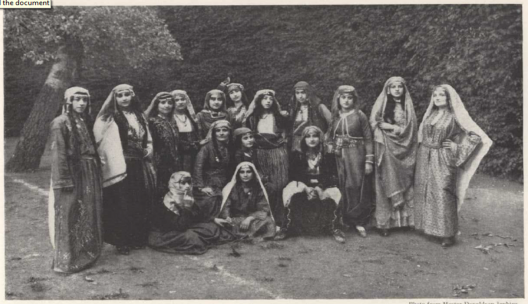
A GROUP OF ARMENIAN GIRLS AT THE AMERICAN COLLEGE FOR GIRLS, CONSTANTINOPLE, REPRESENTING VARIOUS TYPES OF THE ARMENIAN PEOPLE AT THE PAGEANT GIVEN IN JUNE, 1914
"AS students, the Armenians differ among themselves, ranging all the way from dense stupidity to brilliance, but averaging high in their studies. Of the three students who distinguished themselves in philosophy in a dozen years, one was Turkish, one was Greek and one Armenian. In English composition the stories showing the most grace and fancy were written by Armenians. Oriental girls rarely enjoy mathematics, but the one student who so craved mathematics that the professor in that department had to form special classes to give her all that advanced American colleges offer was an Armenian” (see text, page 337).
A CONCERT THAT FAILED
The article in the Berlin treaty has remained a dead letter. No reforms were introduced, and the appeals of the Armenians and their friends in Europe have failed to move the Powers to effective action. The ironically named "Concert of Europe" has never been ready to act together. At one time (icrniany, and at another time Russia, refused to act but between them they sharply irritated the Turkish sultan against his Armenian subjects, and he began a definite policy of massacre against these harmless and useful subjects. The massacre of 1895-96, that at Van in 1906, are some of Unfamiliar illustrations o f this policy, anti have been proved to have been decreed by authority. The purpose of the massacres seems to have been to reduce the number o f Armenians and to take possession of their property. This policy has, of course, driven the law-abiding Armenians into revolutionary societies, which worked for the downfall of Abdul Hamid and have earnestly striven for the freeing o f the Armenian provinces. Independent o f the massacres, which, alas, have been o f too frequent occurrence, what are the grievances of the Armenians against the Ottoman government?
ARMENIAN GRIEVANCES
They may be divided into two classes: those which arise from the deliberate policy of the government and those which arise from the weakness and inefficiency of the government. To the former class belong the massacres, the in impoverishment of the peasantry bv taxation, and the impunity granted to the crimes of Kurds against the Christians, together with the disarming of the latter and the supplying of rifles to the former. To the second class belong disorders, utter failure of justice, wretched and unsafe transportation, and brigandage.

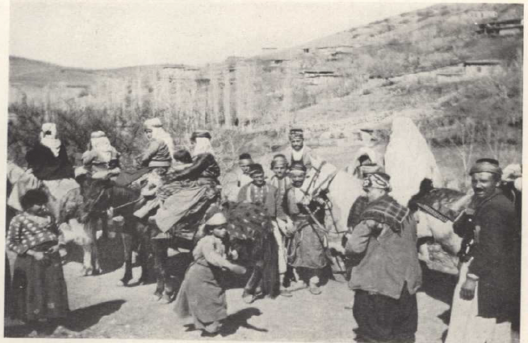
ARMENIAN BRIDESMAIDS
"Hrypsime ran off to join the Red Cross. Wlicn I asked whether her mother knew, she shrugged and said: 'My father gave his life for revolution; why should I try to save mine?’ ” (sec text, раке 340.
In the courts o f justice the word of an Armenian will not he taken against that of a Moslem. The Armenian peasant or trader has to pursue his calling knowing that he cannot travel freely in the empire, recognizing that he will be so heavily and so unfairly taxed that he can scarcely make a living, and then when the struggle of the year is nearly over perhaps the Kurds sweep down from the mountains and seize his home for their winter shelter, take his crops, and even carry off his daughters. No Armenian's life, his property, nor the honor of his women has been safe in Turkey for a century.

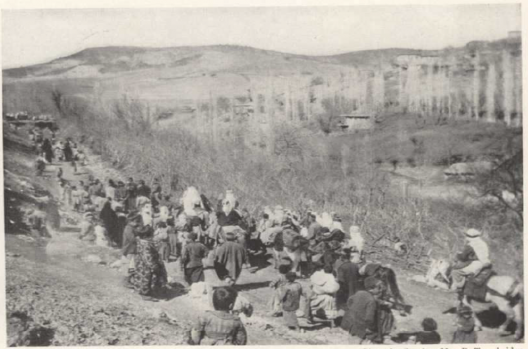
ARMENIAN BRIDAL PROCESSION TO THE CHURCH
"Like the Jew, the Armenian has been oppressed and persecuted, and has developed a strength o f nationality, a love for his own people, and a persistence of type rarely seen elsewhere. Like the Jew, he has learned to bend, not break, before the oppressor”.
The misgovernment of Turkey has found, of course, other victims beside the Armenians. Patriotic Turks have seen their country impoverishment, their people oppressed, their trees cut down, their mineral resources undeveloped, their government despised by Europe, and their patriots and statesmen exiled. Hut hard as was their lot. it was not so hard as that of the Christians, and of the latter the Armenians have suffered the most. The case o f the Turkish people got so bad that in 1908 there broke out in Turkey a revolution, in which all the revolutionary societies of the country joined with the Young Turk party to overthrow Ahdul Ilamid and establish a constitution.

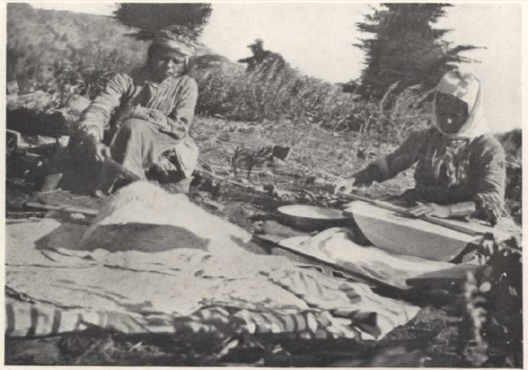
ROLLING OUT BREAD AS THIN AS BLOTTING-PAPER AND BAKING IT ON A DISC OF SHEET-IRON
This is the universal custom of taking unleavened bread in Turkish homes
A TOUCHING FAITH
The enthusiastic belief of the Armenians in this movement was very touching. In the halcyon «lays that followed the announcement of the constitution, priest and imam went together to place (lowers 011 the graves of massacred Armenians.
One of the illustrious exiles who returned to Constantinople was the venerable Armenian patriarch Ismirlian. As his boat came through the Marmora it was met bv thousands of little boats coming out to welcome him. When they drew in sight of Seraglio Point, where the waters of the Bosphorus meet the Marmora. Ismirlian said solemnly: "Let us kneel anil pray over the graves of our «lead. Here below us in the Marmora lie thousands. Let us pray God for their souls!" and, kneeling, he led his sobbing people in prayer.
Many an intelligent Armenian went eagerly to the new Turkish parliament as delegate from his helpful people. It was an Armenian who wrote the song of freedom called “ Fatherland.” One of the most moving sights of that wonderful day when the first parliament met was a body o f several hundreds of Armenians marching through the streets of Stanihoul singing this song of "Fatherland:" they who for a thousand years had not been allowed to feel that they had any fatherland. An attempt to break down the civil inequalities of the population of the empire was made. All citizens henceforth were to take the name of Ottomans, and the Rayahs were released from their special tax and allowed to enter the army.

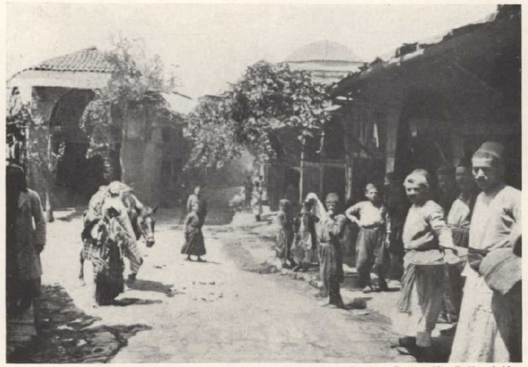
A STREET SCENE IN THE CITY OF MARASH
Marash is the principal city of the saiijalc of the same name, not far from Aleppo. It is famous for its trade in oriental runs and has а 1агце Armenian population
'I here were undoubtedly a good many changes for the better made after the constitution, but the old habits of corruption, of contcmpt for the Rayah, of leniency to the Kurd, and of general inefficiency remained. Armenians in 1900 were sadly shaking their heads anti prophesying that the Young Turk party would fail, when came the counter-revolution, Abdul Hamid's attempt to repossess himself of the power. With supreme cunning he planned a series of massacres that should forever discredit the Young Turk party in Europe. In many cases the governors refused to execute the massacres, but in Cilicia they cook place - a sickening succession of horrors.
The Armenians, infinitely saddened, reluctantly abandoned their hope of freedom through the Turk. Emigration began in considerable numbers to America, and in still larger numbers to Russia.
RUSSIAN'S ARMENIAN POLICES
Russia had long been the possessor of an Armenian question, too, and bail sought to make Russians of its Armenian subjects in Transcaucasia. Its policy at first was one of russification. In 1896 Mr. Hodgetts quotes an Armenian priest of Etchmiadzin as follows: "The great difficulty we Armenians have today is to get education. We are an ancient race, with a noble literature anti a great cultural history behind us: but everything is being done to undermine that culture, to reduce us to the condition of brutes, to make us learn Russian, forget anti neglect our own language, anti thus lieconie assimilated by Russia. But the Russians are intellectually, culturally, and racially our inferiors, and we mean to do all we can to retain our superiority".

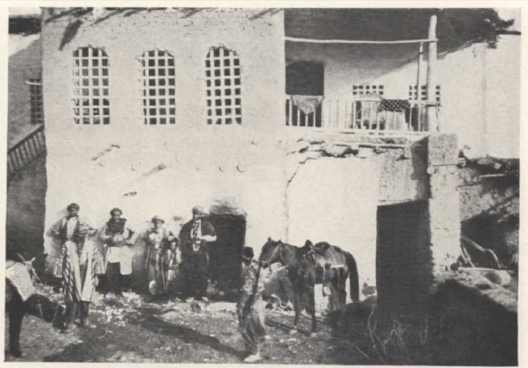
THE HOME OF A TURKISH VILLAGE CHIEF
These local officials often have winked at massacres; the masses delight in them, since it gives the Moslem a chance to divide up the property of the more provident Armenians
In 1903 the Russian government despoiled the sanctuary of Etchmiadzin, carrying away coin and plate and taking over farms and lands lndonging to the church all over the land: furthermore, Armenian churches were closed anti their services forbidden.
The government next attempted to bribe the Armenians to join the Orthodox Church: but neither coercion nor bribe could turn the faithful Armenian from the church of his fathers. This loyalty can hardly be said to spring from religious principle; for, as we have said, the two great Eastern churches differ practically not at all; it was merely another expression of the intense national feeling of the Armenians. Handied from one political rule to another, never knowing political independence nor unity, they have sought that unity in their church. When they were thus suffering persecution, a traveling American missionary asked them, “ Don’t you wish you were still under Turkey?" And the reply came, “ Yes; for Turkey lops off our branches, hut Russia digs us up by the roots.”
But in IQ04 a new viceroy took the government of Russia and the policy was completely changed. The property taken was restored to its former owners, the Armenian Church was once more free, and with the freedom of the church has come the freedom to use their dearly loved vernacular and to maintain their excellent schools. The Armenians of Turkey, noting the improved conditions of their brothers in Russia, are emigrating thither in flocks, ami at the outbreak of the present war in Europe many went over the frontier to offer their services to Russia, and many more are watching with eager hope the progress of the Allies at the Dardanelles.
AMERICANS MAKERS OF ARMENIA
If the Towers have done little for Armenia but raise false hopes, that is not true of the people of Europe and America. French missions are clotted all over Asia Minor, and German societies have cared for children orphaned by the massacres, while English missions, schools, and orphanages attest a deep interest in the Armenians. But the greatest work done among them has been done by the Americans, whose schools and hospitals, says an Englishman, “might almost be called the makers of modern Armenia."

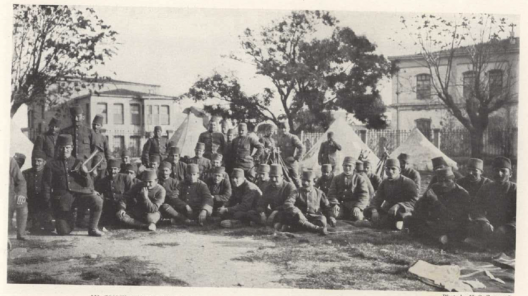
The American mission schools at Marsovan, Adabazar, and scores of other places are filled with Armenians, and the men’s colleges at Constantinople. Smyrna, Beirut, and elsewhere, and the women's college at Constantinople graduate each year numbers of eager, intelligent Armenian men and women.

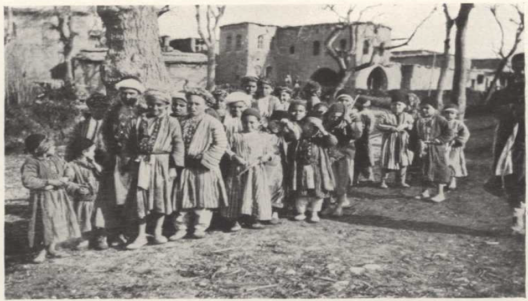
The American Hoard of Foreign Missions, through its hospitals, kindergartens, schools, colleges and churches, its Bible societies and its press, lias done an enonnous work for the Armenians. These institutions have generally been open to other dwellers in the land; but the Armenians in their love for education have always been the first to profit by any school or literature at their doors. Often, also, they have been able to lake the work started by the Americans and carry it on themselves, financing and administering it.

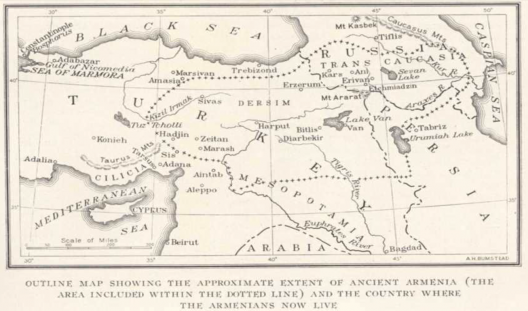

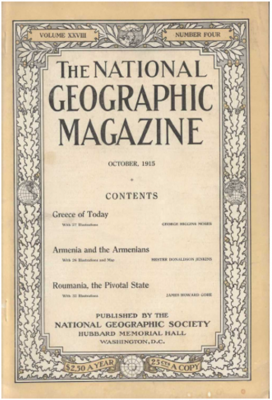
ԲԵՌՆԵԼ ՀՈԴՎԱԾԻ՝ PDF ՏԱՐԲԵՐԿԸ
• ՀՈԴՎԱԾՆԵՐԸ ՄԱՍՆԱԿԻ ԿԱՄ ԱՄԲՈՂՋՈՒԹՅԱՄԲ ԱՐՏԱՏՊԵԼՈՒ ԿԱՄ ՕԳՏԱԳՈՐԾԵԼՈՒ ԴԵՊՔՈՒՄ ՀՂՈՒՄԸ www.anunner.com ԿԱՅՔԻՆ ՊԱՐՏԱԴԻՐ Է :
• ԵԹԵ ԴՈՒՔ ՈՒՆԵՔ ՍՈՒՅՆ ՀՈԴՎԱԾԸ ԼՐԱՑՆՈՂ ՀԱՎԱՍՏԻ ՏԵՂԵԿՈՒԹՅՈՒՆՆԵՐ ԵՎ
ԼՈՒՍԱՆԿԱՐՆԵՐ,ԽՆԴՐՈՒՄ ԵՆՔ ՈՒՂԱՐԿԵԼ ԴՐԱՆՔ info@anunner.com ԷԼ. ՓՈՍՏԻՆ:
• ԵԹԵ ՆԿԱՏԵԼ ԵՔ ՎՐԻՊԱԿ ԿԱՄ ԱՆՀԱՄԱՊԱՏԱՍԽԱՆՈՒԹՅՈՒՆ, ԽՆԴՐՈՒՄ ԵՆՔ ՏԵՂԵԿԱՑՆԵԼ ՄԵԶ` info@anunner.com:
Դիտումների քանակը: 8732
| Կիսվել : |

«Ցեղի կանչը». Գագիկ Գինոսյան

ՏԻԳՐԱՆ ՀԱՄԱՍՅԱՆ

 ՍԱՐԳԻՍ ԿԱՍՅԱՆ (ՏԵՐ-ԳԱՍՊԱՐՅԱՆ) ՀՈՎՀԱՆՆԵՍԻ
Պետական գործիչ, հրապարակախոս:
ՌՍԴԲԿ անդամ 1905-ից:
Ավելին...
ՍԱՐԳԻՍ ԿԱՍՅԱՆ (ՏԵՐ-ԳԱՍՊԱՐՅԱՆ) ՀՈՎՀԱՆՆԵՍԻ
Պետական գործիչ, հրապարակախոս:
ՌՍԴԲԿ անդամ 1905-ից:
Ավելին...

















 Arian AMU
Arian AMU
